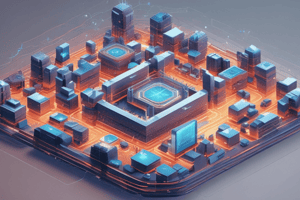Podcast
Questions and Answers
What is the primary use case for the MQTT protocol?
What is the primary use case for the MQTT protocol?
- Real-time data exchange between devices
- Remote monitoring applications (correct)
- High-speed data transfer in local networks
- Communication in data-heavy environments
Which method is NOT supported by CoAP?
Which method is NOT supported by CoAP?
- POST
- GET
- DELETE
- UPDATE (correct)
What is the main characteristic of WebSockets?
What is the main characteristic of WebSockets?
- It connects devices over long distances.
- It is optimal for sending large files.
- It facilitates real-time data exchange. (correct)
- It provides a one-way communication channel.
In which scenario is LoRa technology most suitable?
In which scenario is LoRa technology most suitable?
Which statement defines the term 'network topology'?
Which statement defines the term 'network topology'?
What does batch processing primarily involve?
What does batch processing primarily involve?
Which of the following is NOT a common challenge in IoT security?
Which of the following is NOT a common challenge in IoT security?
What can unauthorized access to IoT devices lead to?
What can unauthorized access to IoT devices lead to?
Which botnet is known for utilizing IoT devices to perform DDoS attacks?
Which botnet is known for utilizing IoT devices to perform DDoS attacks?
What is a potential consequence of data interception in IoT?
What is a potential consequence of data interception in IoT?
What is the primary function of sensors in an IoT system?
What is the primary function of sensors in an IoT system?
Which layer of the IoT architecture is responsible for transferring data from the perception layer?
Which layer of the IoT architecture is responsible for transferring data from the perception layer?
Which of the following protocols is NOT commonly used in IoT systems?
Which of the following protocols is NOT commonly used in IoT systems?
What significant advancement in the 2000s significantly impacted the development of IoT?
What significant advancement in the 2000s significantly impacted the development of IoT?
What is an example of an IoT application in the healthcare sector?
What is an example of an IoT application in the healthcare sector?
Who coined the term 'Internet of Things' and when?
Who coined the term 'Internet of Things' and when?
Which component of IoT allows users to interact with the system?
Which component of IoT allows users to interact with the system?
What aspect of IoT has seen rapid growth in the 2010s and beyond?
What aspect of IoT has seen rapid growth in the 2010s and beyond?
What is a primary advantage of using cloud storage solutions for IoT data?
What is a primary advantage of using cloud storage solutions for IoT data?
Which of the following best describes edge computing?
Which of the following best describes edge computing?
What is the primary function of Microsoft Azure IoT Hub?
What is the primary function of Microsoft Azure IoT Hub?
Which technique involves combining data from multiple sources to create a unified view?
Which technique involves combining data from multiple sources to create a unified view?
Why might cloud computing introduce delays when processing IoT data?
Why might cloud computing introduce delays when processing IoT data?
Which aspect of IoT analytics helps in reducing energy costs in smart homes?
Which aspect of IoT analytics helps in reducing energy costs in smart homes?
In the context of IoT data, what does machine learning primarily assist with?
In the context of IoT data, what does machine learning primarily assist with?
Which of the following is NOT a characteristic of cloud storage solutions for IoT?
Which of the following is NOT a characteristic of cloud storage solutions for IoT?
What is the primary function of a proximity sensor?
What is the primary function of a proximity sensor?
Which type of actuator is specifically known for providing precise control of angular position?
Which type of actuator is specifically known for providing precise control of angular position?
What distinguishes the ESP32 from its predecessor, the ESP8266?
What distinguishes the ESP32 from its predecessor, the ESP8266?
In which scenario would a solenoid be most appropriately used?
In which scenario would a solenoid be most appropriately used?
Which of the following microcontrollers is noted for its ability to run a full operating system?
Which of the following microcontrollers is noted for its ability to run a full operating system?
What does PWM stand for, and what is its role in servos?
What does PWM stand for, and what is its role in servos?
Which protocol would be most suitable for an IoT device needing low power consumption?
Which protocol would be most suitable for an IoT device needing low power consumption?
What enables microcontrollers to communicate with other devices in an IoT environment?
What enables microcontrollers to communicate with other devices in an IoT environment?
What is the purpose of encryption in IoT security?
What is the purpose of encryption in IoT security?
Which of the following best describes the function of multi-factor authentication (MFA) in IoT?
Which of the following best describes the function of multi-factor authentication (MFA) in IoT?
Why is network segmentation important in IoT environments?
Why is network segmentation important in IoT environments?
What is the role of the voltage regulator in an Arduino kit?
What is the role of the voltage regulator in an Arduino kit?
What does device hardening aim to achieve?
What does device hardening aim to achieve?
Which feature ensures that only authenticated and trusted code runs on IoT devices during startup?
Which feature ensures that only authenticated and trusted code runs on IoT devices during startup?
What is the purpose of data anonymization in IoT?
What is the purpose of data anonymization in IoT?
Which component of the Arduino kit can be programmed to control electronic components?
Which component of the Arduino kit can be programmed to control electronic components?
Flashcards
IoT (Internet of Things)
IoT (Internet of Things)
A network of physical objects embedded with sensors and software, communicating over the internet.
Sensors/Devices (IoT)
Sensors/Devices (IoT)
Collect data from the environment in an IoT system.
Connectivity (IoT)
Connectivity (IoT)
Transmits data from sensors to cloud services in IoT.
Data Processing (IoT)
Data Processing (IoT)
Signup and view all the flashcards
User Interface (IoT)
User Interface (IoT)
Signup and view all the flashcards
MQTT
MQTT
Signup and view all the flashcards
Smart Home
Smart Home
Signup and view all the flashcards
Perception Layer (IoT)
Perception Layer (IoT)
Signup and view all the flashcards
Proximity Sensor
Proximity Sensor
Signup and view all the flashcards
Actuator
Actuator
Signup and view all the flashcards
Motor (DC/Stepper)
Motor (DC/Stepper)
Signup and view all the flashcards
Servo Motor
Servo Motor
Signup and view all the flashcards
Solenoid
Solenoid
Signup and view all the flashcards
Microcontroller
Microcontroller
Signup and view all the flashcards
Arduino
Arduino
Signup and view all the flashcards
IoT Communication Protocol
IoT Communication Protocol
Signup and view all the flashcards
MQTT
MQTT
Signup and view all the flashcards
CoAP
CoAP
Signup and view all the flashcards
HTTP
HTTP
Signup and view all the flashcards
WebSockets
WebSockets
Signup and view all the flashcards
Network Topology
Network Topology
Signup and view all the flashcards
Batch Processing Definition
Batch Processing Definition
Signup and view all the flashcards
IoT Security Focus
IoT Security Focus
Signup and view all the flashcards
IoT Security Challenges
IoT Security Challenges
Signup and view all the flashcards
Unauthorized Access (IoT)
Unauthorized Access (IoT)
Signup and view all the flashcards
DDoS Attack (IoT)
DDoS Attack (IoT)
Signup and view all the flashcards
Cloud Storage Solutions
Cloud Storage Solutions
Signup and view all the flashcards
Edge Computing
Edge Computing
Signup and view all the flashcards
Cloud Computing
Cloud Computing
Signup and view all the flashcards
IoT Analytics
IoT Analytics
Signup and view all the flashcards
Data Filtering
Data Filtering
Signup and view all the flashcards
Data Aggregation
Data Aggregation
Signup and view all the flashcards
Data Transformation
Data Transformation
Signup and view all the flashcards
Real-time Processing
Real-time Processing
Signup and view all the flashcards
Firmware Vulnerabilities
Firmware Vulnerabilities
Signup and view all the flashcards
Encryption (IoT)
Encryption (IoT)
Signup and view all the flashcards
TLS
TLS
Signup and view all the flashcards
Arduino Board (Component)
Arduino Board (Component)
Signup and view all the flashcards
Network Segmentation
Network Segmentation
Signup and view all the flashcards
Secure Booting (IoT)
Secure Booting (IoT)
Signup and view all the flashcards
Data Anonymization
Data Anonymization
Signup and view all the flashcards
Arduino Pin (Digital I/O)
Arduino Pin (Digital I/O)
Signup and view all the flashcards
Study Notes
Internet of Things (IoT)
- Network of physical objects embedded with sensors, software, and other technologies
- Network of interconnected devices that communicate with each other over the internet
- Components: sensors/devices, connectivity, data processing, user interface
Components of IoT
- Sensors/Devices: collect data from environment (temperature, cameras, GPS).
- Connectivity: transmits data to cloud services (Wi-Fi, Bluetooth, cellular networks).
- Data Processing: analyses collected data for meaningful information.
- User Interface: allows users to interact with the IoT system.
Architecture of IoT
- Perception Layer: sensors and actuators that collect data.
- Network Layer: transfers data to processing systems.
- Processing Layer: processes data and makes decisions.
- Application Layer: specific application-oriented services for users.
Communication Protocols
- Used in IoT systems, enabling interaction between devices and the internet (e.g. MQTT, HTTP/HTTPS, CoAP, Zigbee).
History and Evolution of IoT
- Early 1980s: modified Coca-Cola vending machine at Carnegie Mellon University.
- 1990s: "Internet of Things" coined by Kevin Ashton. Internet connected to physical world via sensors.
IoT Applications and Market Trends
- Smart Homes: smart thermostats, lights, security cameras, voice assistants.
- Healthcare: wearable fitness trackers, smart medical devices, remote patient monitoring.
- Industrial IoT (IIoT): predictive maintenance, real-time monitoring, supply chain optimization.
- Agriculture: precision farming, automated irrigation, livestock monitoring.
- Smart Cities: smart traffic management, parking solutions, waste management, energy-efficient buildings.
IoT Architecture and Design Principles
- Basic Architecture: typically divided into three layers: Perception, Network, and Application Layers.
- Key Components: Sensors (detect & measure physical properties), Actuators (perform actions).
- Microcontrollers process sensor data and control actuators. Including: Arduino boards.
Microcontrollers and IoT Platforms
- Microcontrollers: small computing devices for specific tasks in embedded systems.
- Popular microcontrollers: Arduino, Raspberry Pi, ESP8266, ESP32.
IoT Communication Protocols
- MQTT (Message Queuing Telemetry Transport): lightweight publish/subscribe messaging protocol. Ideal for low bandwidth, high latency networks.
- CoAP (Constrained Application Protocol): specialized web protocol for resource-constrained devices. Similar to HTTP, optimized for low power.
- HTTP (HyperText Transfer Protocol): widely used application layer protocol for sending data over the web.
- WebSockets: enables real-time data exchange between client and server (full-duplex communication). Ideal for systems needing continuous communication.
- Wireless communication technologies: WiFi, Bluetooth, Zigbee, LoRa (long range).
IoT Data Management and Storage
- Data generated by devices is collected, stored, processed, and analyzed.
- Cloud storage solutions handle large volumes of IoT data. Edge computing processes data locally reducing latency.
- Key Techniques include: Data Filtering, Data Aggregation, Data Transformation, and Machine Learning.
IoT Security and Privacy
- Security focuses on protection from malicious attacks, unauthorized access, and data breaches.
- Common threats: unauthorised access, DDoS attacks, malware, and firmware vulnerabilities.
- Security protocols and best practices (like encryption) are necessary to protect data.
Studying That Suits You
Use AI to generate personalized quizzes and flashcards to suit your learning preferences.




